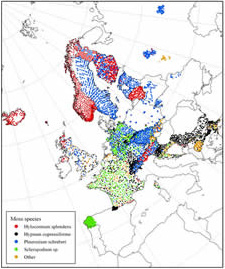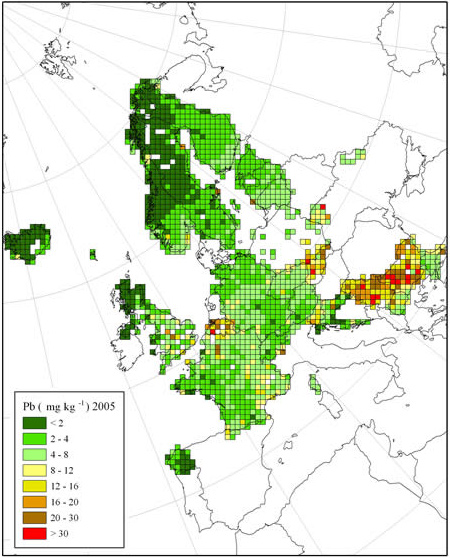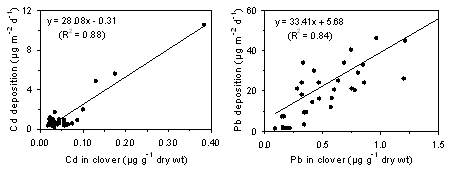Welcome to DATA MANAGEMENT SYSTEM (DMS) of the UNECE ICP Vegetation!
This SYSTEM is created at the cloud platform of the Joint Institute for Nuclear Research (Dubna, Russia) for collection, storage and process of information on atmospheric deposition of heavy metals (HM), nitrogen (N), persistent organic compounds (POPs) and radionuclides (RN) – assessment based on moss analysis
Latest survay

Mosses as biomonitors of air pollution: 2015/2016 survey on heavy metals, nitrogen and POPs in Europe and beyond
Publisher: Joint Institute for Nuclear Research, Dubna, Russian FederationISBN: 978-5-9530-0508-1
Can be downloaded here
ICP Vegetation
The International Cooperative Programme on Effects of Air
Pollution on Natural Vegetation and Crops
The ICP Vegetation was established in 1987 under the United Nation Economic Commission for Europe (UNECE) Convention on Long-Range Transboundary Air Pollution (LRTAP).The ICP Vegetation is an international research programme investigating the impacts of air pollutants on crops and (semi-)natural vegetation and reports to the Working Group on Effects (WGE). The programme focuses on the following air pollution problems: impacts of ozone pollution on vegetation and the atmospheric deposition of heavy metals and nitrogen to vegetation. In addition, the ICP Vegetation is taking into consideration impacts of pollutant mixtures (e.g. ozone and nitrogen), consequences for biodiversity and the modifying influence of climate change on the impacts of air pollutants on vegetation. The results of studies conducted by the ICP Vegetation are used in assessments of the current, and predictions of the future, state of the environment. Thirty five Parties to the LRTAP Convention participate in the programme. The programme is led by the UK, has its Programme Coordination Centre at the Centre for Ecology and Hydrology - Bangor and is funded by the Department for Environment Food and Rural Affairs(Defra).
Research
Activities
- European surveys of heavy metal accumulation in mosses.
- Temporal trends in heavy metal accumulation in mosses (1990-2005).
- Studying heavy metal deposition to white clover.
- Heavy metal deposition and potential contamination of food crops.
European surveys of heavy metal accumulation in mosses
The heavy metals in mosses survey was originally established in 1980 as a Swedish initiative under the leadership of Åke Rühling, Sweden. During 2001, responsibility for the coordination of the project was handed over from the Nordic Working Group on Monitoring and Data, Nordic Council of Ministers, to the ICP Vegetation Programme Coordination Centre at CEH Bangor. Surveys are conducted every 5 years. By 2005, the study had expanded to include 28 European countries and 6,000 samples of mosses.

The idea of using mosses to measure atmospheric heavy metal deposition had been developed in the late 1960s. It is based on the fact that mosses, especially the carpet-forming species, obtain most of their nutrients directly from precipitation and dry deposition; there is little uptake of metals from the soil. Heavy metals deposited from the atmosphere tend to be retained by the mosses thereby making sampling and chemical analysis more robust. It is easier and cheaper than conventional precipitation analysis as it avoids the need for deploying large numbers of precipitation collectors with an associated long-term programme of routine sample collection and analysis.
Data on the concentrations in mosses of the following heavy metals are collated, analysed and mapped by the ICP Vegetation Programme Centre: arsenic, cadmium, chromium, copper, iron, lead, mercury, nickel, vanadium, zinc; aluminium and antimony since 2005. Data show that in general the lowest concentrations are observed in (north) Scandinavia, the Baltic States and northern parts of the United Kingdom and the higher concentrations in Belgium and eastern European countries (see maps temporal trends below). However, spatial trends are metal-specific. The next moss survey is planned for 2010.
Bivariate analysis of the data showed the highest correlations between the cadmium and lead concentration in mosses and i) modelled EMEP depositions, ii) EMEP total emissions and iii) the ratio of urban land use in a 100 km radius. Correlations between the mercury concentration in mosses and modelled EMEP depositions or anthropogenic emissions were low. Multivariate analysis identified total modelled deposition to be statistically the most significant factor influencing the cadmium and lead concentration in mosses, whereas for mercury moss species was the most significant factor determining its concentration in mosses.
Temporal trends in heavy metal accumulation in mosses (1990 – 2005)
An important part of the work at the Programme Coordination Centre has been to analyse the trends in the database. Europe-wide a dramatic decline in the concentrations of arsenic (72%), lead (72%), vanadium (60%) cadmium (52%) and iron (45%) was observed between 1990 and 2005, with a smaller decline being reported for zinc (29%), copper (20%) and nickel (20%). The decline for mercury (12%) and chromium (2%) was not significant. The temporal trends in heavy metal concentrations in mosses are in agreement with trends in emission and/or modelled deposition data reported for Europe (see annual report 2008/9 - to follow). However, temporal trends were country or region-specific, with no changes or even increases being observed. Therefore, even in times of generally decreasing metal depositions across Europe, temporal trends are different for different geographical scales.


Studying heavy metal deposition to white clover
In 1998, 2000, 2002 and 2004 participants in the ozone biomonitoring programme with white clover (see ozone) took part in a study to investigate the heavy metal concentration in white clover in order to provide information on ‘normal’ background concentrations and pollution thresholds. The background concentrations were 0.065 µg Cd g-1 dry matter, 3.50 µg Cu g-1 DM and 0.15 µg Pb g-1 DM and the pollution thresholds were 4.15 µg Cu g-1 DM and 0.36 µg Pb g-1 DM, respectively. For cadmium only a preliminary pollution threshold of 0.155 µg g-1 could be established. For copper the background concentration and the pollution threshold are not far apart. At about half of the participating sites in Europe the pollution thresholds for copper and lead were exceeded at some time during the growth period. Although the white clover biomonitoring network was working well for the trace elements lead and copper, more data from polluted sites are needed to establish the pollution threshold for cadmium. The use of a standard soil low in cadmium is required to prevent confounding effects of the uptake of cadmium by the roots.

Heavy metal deposition and potential contamination of crops
The ICP Vegetation has contributed to a review by the Task Force on Health regarding ‘Health risks of heavy metals from long-range transboundary air pollution’. Atmospheric deposition of metals has a direct effect on the contamination of crops used for human and animal consumption. Leafy vegetables are particularly vulnerable to the atmospheric impact of arsenic, lead and mercury. Away from pollution sources the deposition of arsenic is rather low but atmospheric deposition remains important as a main source of contamination of leafy vegetables. The contribution of atmospheric cadmium to the accumulated level in crops is often less important than that of soil-borne cadmium. There is limited transfer of cadmium to humans via consumption of animal products, except for offal. Lead is a widespread pollutant having a direct impact on above-ground plant parts. Even at remote sites there is still a clear impact of lead deposition on its concentration in leaves and wheat grain. A decrease in atmospheric deposition will have a beneficial effect on the daily intake by humans. In crops, atmospheric deposition is the main source of inorganic mercury. However, most crops have a rather low accumulation rate although some crops (curly kale, some herbs) are able to accumulate considerably more. A decrease of atmospheric mercury would result in a decreased mercury load for humans.
Main results for heavy metals are:
- The moss survey provides a cost effective method for monitoring heavy metal pollution across Europe at a high spatial resolution. Heavy Metall Moss Report
- Spatial trends of heavy metal concentrations in mosses are metal-specific. However, in general the lowest concentrations are observed in (north) Scandinavia, the Baltic States and northern parts of the United Kingdom and the higher concentrations in Belgium and eastern European countries. Heavy Metall Moss Report
- For cadmium and lead, concentration in mosses show the highest correlations with modelled depositions, followed by total emissions and the proportion of urban land use in a 100 km radius in Europe. For mercury, correlations between the concentration in mosses and modelled depositions or anthropogenic emissions are low. Annual Report
- Between 1990 and 2005, the metal concentration in mosses has declined for arsenic (72%), cadmium (52%), copper (20%), iron (45%), nickel (20%), lead (72%), vanadium (60%) and zinc (29%), but not for chromium and mercury. Despite these general European trends, country and region-specific temporal trends were observed, including increases in metal concentrations. Heavy Metall Moss Report
Moss survey protocol
Since the late 1960s, mosses have been used as biomonitors of atmospheric deposition of heavy metals in the Nordic Countries. From 1990 onwards, the European heavy metals in mosses survey has been conducted every five years. In 2005, the total nitrogen concentration in mosses was also determined for the first time. In 2010, a pilot study for persistent organic pollutants (POPs) was included and we encourage more countries to include POPs in the 2015 survey. Mosses are sampled according to a standardised protocol. The next European moss survey will take place in 2015/16 and the manual for sampling mosses and the spreadsheet for submitting data can be downloaded here. From 2014 onwards the Moss Survey Coordination Centre is at the Joint Institute for Nuclear Research (JINR), Dubna, Russian Federation. The new Moss Survey Coordination Centre is also keen to assess the suitability of mosses as biomonitors of radionuclides. For further details or queries regarding the 2015/16 moss survey, please contact Marina Frontasyeva - mfrontasyeva@jinr.ru
Coordination
| Moss Survey Coordination Centre | Programme Coordination Centre |
| Dr. Marina Frontasyeva (marina@nf.jinr.ru) | Dr. Harry Harmens (hh@ceh.ac.uk) |
| Frank Laboratory of Neutron Physics | Centre for Ecology and Hydrology |
| Joint Institute for Nuclear Research | Environment Centre Wales |
| Str. Joliot-Curie, 6, Dubna, Moscow Region, Russian Federation | Deiniol Road, Bangor, Gwynedd LL57 2UW, United Kigdom |
| Tel.: +7(49621)65609 | Tel.: +44(0)1248 374512/374500 |
| Fax.: +7(49621)65085 | Fax: +44 (0)1248 362133 |
Publications
2015/2016 Moss survey:
M. Frontasyeva, H. Harmens, A. Uzhinskiy, O. Chaligava, Vergel Konstantin, Yushin Nikita, Dunaev Anatoly, Rumyantsev Igor, Blinova Eleonora, Ivanov Sergey, Lynnik Vitaly, Gromov Sergey, Korotkov Vladimir, Gitarski Mihail, Pozdnyakova Ekaterina, Konkova Elisaveta, Polikarpova Natalia, Kukhta Anna, Yurij Buyvolov, Gorelova Svetlana, Volkova Elena, Babicheva Darya, Ignatova Tatyana, Koroleva Julia, Ananyan Anahit, Ramazanov Bakhruz, Bukharina Irina, Zhuravleva Anastasiya, Volkov Nikita, Vasileva Natalia, Shvetsova Margarita, Gundorina Svetlana, Ostrovnaya Tatyana, and al and. Mosses as biomonitors of air pollution: 2015/2016 survey on heavy metals, nitrogen and POPs in Europe and beyond. Report of the ICP Vegetation Moss Survey Coordination Centre. Joint Institute for Nuclear Research (JINR) Dubna, Russian Federation, 2020.
DMS:
A. Uzhinskiy, G. Ososkov, M. Frontasieva Management of environmental monitoring data: UNECE ICP Vegetation case, // Proceedings of the 27th Symposium on Nuclear Electronics and Computing, CEUR Workshop Proceedings 2507, p. 202-207, 2019 http://ceur-ws.org/Vol-1752/paper33.pdf
Moss species images database
For our mobile application (Moss ICP at Google Play) we collected an dataset of five moss spices (Abietinella Abietina, Hylocomium Splendens, Hypnum Cupressiforme, Pleurozium Schreberi, and Pseudoscleropodium Purum). There are 599 images at the database now. The archive with the database can be downloaded and used with the citation on the DMS. The classification can be executed through the mobile application or the web-form.





Example of images at the database